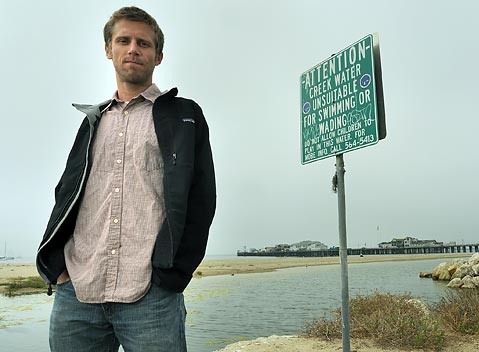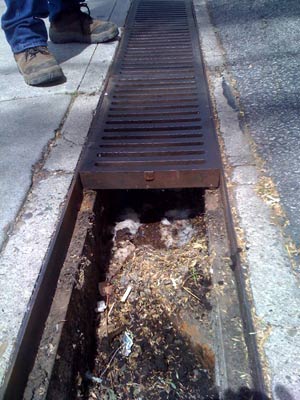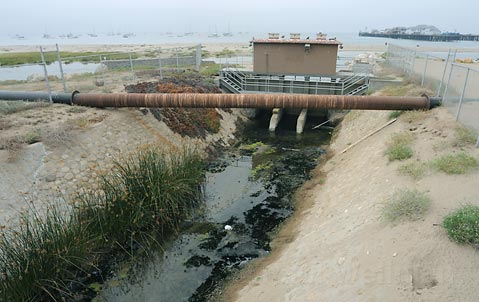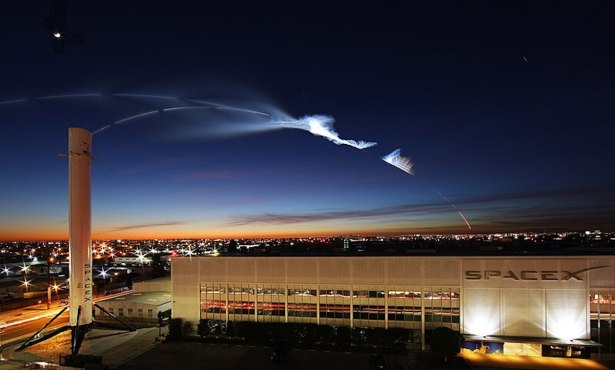East Beach Water Contamination Mystery Continues
Looking Out for Number Two

A mystery is unfolding in the sand along Santa Barbara’s East Beach, and chances are the tourism board doesn’t want you to know about it.
To the casual observer, the two occasionally commingled lagoons sitting high in the sand east of Stearns Wharf are as much a part of downtown’s waterfront landscape as the dolphin fountain. The two bodies of water -Mission Lagoon nearest the wharf and the so-called Laguna Lagoon farther east-are normal and intended near-final resting places for storm runoff and natural watershed flow before it ultimately makes its way into the Pacific ocean. They have also been the subject of longstanding speculation by city officials and water quality watchdogs for their possible connection to years’ worth of safety warnings and less-than-stellar dry-weather water quality reports for the beach that borders them.

Now, thanks to a recently released study on the Laguna watershed-an approximately 630-acre area mostly comprising eastern downtown Santa Barbara-that murky connection is a little bit clearer. According to the report, which was compiled by UCSB and the Santa Barbara-based geology firm Geosyntec Consultants and which was presented at the city’s Creeks Advisory Committee late last month, there is “significant input of human fecal waste” into some of the storm drains and channel that feed the Laguna Lagoon. But the origin and volume of this waste remains unknown. “That is the million-dollar question,” said Cameron Benson, Santa Barbara’s creeks division manager. “If we knew the source right now, we would stop it and it would be done, but unfortunately, it isn’t that easy.”
“When one person finds two of these things in 18 months, it really makes you wonder what else is out there,” explained Ben Pitterle, acting policy manager for environmental nonprofit Santa Barbara Channelkeeper. Pitterle was referring to his accidental discovery of two examples of human waste being directly and unknowingly deposited into area watersheds. The first was an illegal pipe flowing into a Cieneguitas Creek tunnel underneath Highway 154 that was connected to a toilet in Sansum medical clinic’s urology department. The second, which Pitterle came upon while walking near the corner of Garden and Canon Perdido streets, was a commercial building toilet flushing straight into a Laguna watershed storm drain. While both instances have since been investigated and remedied by city wastewater crews, they illustrate just how varied, covert, and blatant human waste sources can be. Add to that illegal RV dumping, homeless “direct deposits” on creek beds, unplanned bowel evacuations by runners, and, of course, hundreds of miles of aging sewer mains and lateral lines buried within city limits, and you have a tough code to crack in determining the dirty water’s source. “It really is like trying to find the needle in the haystack,” Benson said.

That source identification, however, is vital to improving water quality, and the city knows it. To that end, the city’s water resource manager, Rebecca Bjork, said Santa Barbara actually has a “leg up on most other communities in Southern California.” Each year for the past 25 years, the city has been replacing one percent of its 277 miles of sewer mains. Furthermore, the city has, for the past two-and-a-half years, been helping fund the replacement of privately owned lateral lines-the plumbing that connects what’s flushed in houses or offices to the city’s sewer lines. While Bjork explains that this process-which has so far accounted for some 600 lines out of an estimated 27,500-is actually being done in the name of preventing backups, blockages, and spills in the city’s sewer main system rather than correcting potentially leaky laterals, it has yielded “zero evidence” that suggests lateral lines are causing the contamination. Bjork is optimistic about the city’s many miles of mains despite several being nearly a century old, explaining that they are annually inspected with cameras and smoke tests. Further, she is confident that the “high-priority” pipes have already been replaced. Benson, who prior to his city role was executive director of the Environmental Defense Center, added, “Protecting public health is our number-one priority, so obviously you have to keep looking [at sewer mains], but I am satisfied that the wastewater department is doing everything it can to ensure that that isn’t the problem.”
Folks from Channelkeeper and fellow water quality champion Heal the Ocean aren’t so convinced. Acknowledging that there are “tons of good work” being done by the city on water quality issues, Pitterle said it might be premature to rule out laterals or mains as contributors to the crappy situation at East Beach. Pointing to the complex interrelationship between Santa Barbara’s shallow groundwater table, surface flows, rainstorms, and cracks in sewer lines, Pitterle opined, “We just don’t fully understand that connection enough to say 100 percent that this is or isn’t part of the problem.”
Furthermore, critics say the rate at which the city’s sewer infrastructure is being replaced is less than perfect. Laments Pitterle, “I know times are tough and that it is an expensive process, but 100 years to get it all done?” And even that estimate could be a bit off, admitted Bjork, who says funding for the replacements could be harmed by the high demand for private lateral replacements. Add to that the logistics of checking nearly 30,000 lateral lines at the industry standard of about three a day and the result is almost 30 years of work before all potential toilet-to-storm drain connections or faulty laterals could be ruled out-a hunt that might be, regardless of good intentions and funding, virtually impossible. “Not only would that degree of testing be expensive, but I think it would ultimately be useless,” explained Benson, noting that testers would have to start over as soon as they finished if new lines and toilets were added during the process.
Underscoring the water quality mystery is the safety of those recreating at East Beach, a stretch of coastline that has averaged 22 health warnings a year for much of the past decade. To that end, the recently released study suggests, among other things, a UV filtration device be installed at the pump station upstream from Laguna Lagoon to zap unwanted bacteria and pathogens. In addition to funding issues, such a project means the city must obtain approval from both California Fish and Game and the California Coastal Commission. Meanwhile, city officials stress that not only is the beach safe but also that the levels of detection cited in the study, which was conducted from July to September 2008, are slightly above state thresholds. (“We are not, by any means, talking about flowing raw sewage, here,” Benson said.) Even so, while the investigation is anything but complete, involved parties say that the only true solution is community awareness about the infinite ways in which humans impact their beaches. As Benson put it, “Where everybody is part of the problem, things like this make it pretty clear that everybody needs to be part of the solution.”



